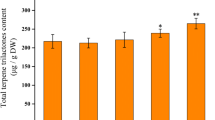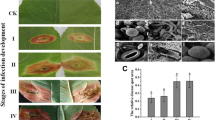Abstract
Key message
Pruning could significantly promote branch formation, root development, and leaf growth, especially, improve flavonol glycoside and terpene lactones accumulation in leaves of ginkgo seedlings.
Abstract
Ginkgo biloba, an economically important tree species, is used as a medicinal plant due to the various secondary metabolites in its leaves. Pruning is the process of cutting branches to facilitate vegetative or reproductive growth. However, little is known about the effects of pruning on active compound accumulation in medicinal plants. Here, we found that after pruning 2-year-old ginkgo seedlings, branch number, ground diameter, and root size increased significantly; in particular, leaf size and crack number increased dramatically. Importantly, after pruning, fresh and dry leaf weights increased. Meanwhile, the total flavonoid, flavonol glycoside, and isorhamnetin contents of the leaves increased significantly, by about 24%, 20%, and 22%, respectively, and the contents of terpene lactones in leaves and roots increased by 8% and 28%, respectively. Through quantitative real-time polymerase chain reaction (qRT-PCR) analysis, we detected upregulation of flavonoid synthesis-associated genes, including chalcone synthase (CHS), flavonoid 3′-hydroxylase (F3'H), flavonol synthase (FLS), flavanone 3-hydroxylase (F3H) and anthocyanin synthase (ANS), and the terpene lactone synthesis-related genes acetyl-CoA C-acetyltransferase (AACT) in leaves after pruning. These results indicate that pruning promotes leaf growth and bioactive compound accumulation in ginkgo seedlings.









Similar content being viewed by others
References
Buer CS, Imin N, Djordjevic MA (2010) Flavonoids: new roles for old molecules. J Integr Plant Biol 52:98–111
Chan PC, Xia Q, Fu PP (2007) Ginkgo biloba leave extract: biological, medicinal, and toxicological effects. J Environ Sci Health C Environ Carcinog Ecotoxicol Rev 25:211–244
Clark JR, Matheny N (2010) The research foundation to tree pruning: a review of the literature. Arboricult Urban for 36:110–120
Du J-f, Li P, Lu X (2021) Advance in biosynthesis and metabolic regulation of ginkgolides. China J Chin Materia Med 46:3288–3297
Erffelinck ML, Goossens A (2018) Review: endoplasmic reticulum-associated degradation (ERAD)-dependent control of (Tri)terpenoid metabolism in plants. Planta Med 84:874–880
Gou JY, Felippes FF, Liu CJ, Weigel D, Wang JW (2011) Negative regulation of anthocyanin biosynthesis in Arabidopsis by a miR156-targeted SPL transcription factor. Plant Cell 23:1512–1522
Guan R, Zhao Y, Zhang H, Fan G, Liu X, Zhou W, Shi C, Wang J, Liu W, Liang X, Fu Y, Ma K, Zhao L, Zhang F, Lu Z, Lee SM, Xu X, Wang J, Yang H, Fu C, Ge S, Chen W (2016) Draft genome of the living fossil Ginkgo biloba. Gigascience 5:49
Herrschaft H, Nacu A, Likhachev S, Sholomov I, Hoerr R, Schlaefke S (2012) Ginkgo biloba extract EGb 761(R) in dementia with neuropsychiatric features: a randomised, placebo-controlled trial to confirm the efficacy and safety of a daily dose of 240 mg. J Psychiatr Res 46:716–723
Ikeuchi M, Ogawa Y, Iwase A, Sugimoto K (2016) Plant regeneration: cellular origins and molecular mechanisms. Development 143:1442–1451
Isah T (2015) Rethinking Ginkgo biloba L.: medicinal uses and conservation. Pharmacogn Rev 9:140–148
Ismail BP (2017) Ash content determination. Food analysis laboratory manual. Springer International Publishing, pp 117–119
Jia Z, Zhao B, Liu S, Lu Z, Chang B, Jiang H, Cui H, He Q, Li W, Jin B, Wang L (2020) Embryo transcriptome and miRNA analyses reveal the regulatory network of seed dormancy in Ginkgo biloba. Tree Physiol 41:571–588
Kim SM, Kim SU (2010) Characterization of 1-hydroxy-2-methyl-2-(E)-butenyl-4-diphosphate synthase (HDS) gene from Ginkgo biloba. Mol Biol Rep 37:973–979
Li W, Wang L, He Z, Lu Z, Cui J, Xu N, Jin B, Wang L (2020a) Physiological and transcriptomic changes during autumn coloration and senescence in Ginkgo biloba leaves. Hortic Plant J 6:396–408
Li W, Ye Y, Cheng F, Lu Y, Jin B, Wang L (2020b) Cytological and proteomic analysis of Ginkgo biloba pollen intine. Hortic Plant J 6:257–266
Liu Y-J, Zhang X-N, Cheng Q-Q, Huang L-Q, Gao W (2013) Advances in studies on 3-hydroxy-3-metllylglutaryl coenzyme A reductase in terpenoids biosynthesis of medicinal plants. China J Chin Materia Med 38:3226–3233
Lu J, Xu Y, Meng Z, Cao M, Liu S, Kato-Noguchi H, Yu W, Jin B, Wang L (2021) Integration of morphological, physiological and multi-omics analysis reveals the optimal planting density improving leaf yield and active compound accumulation in Ginkgo biloba. Ind Crop Prod 172:114055
Mehta N, Jain A, Rajkumar M (2020) Impact of pruning of Diospyros melanoxylon Roxb. (Tendu) bushes on yield and quality of leaves in Maharashtra. J Pharmacogn Phytochem 9:1360–1365
Nafis T, Akmal M, Ram M, Alam P, Ahlawat S, Mohd A, Abdin MZ (2010) Enhancement of artemisinin content by constitutive expression of the HMG-CoA reductase gene in high-yielding strain of Artemisia annua L. Plant Biotechnol Rep 5:53–60
Ni J, Ruan R, Wang L, Jiang Z, Gu X, Chen L, Xu M (2020) Functional and correlation analyses of dihydroflavonol-4-reductase genes indicate their roles in regulating anthocyanin changes in Ginkgo biloba. Ind Crop Prod 152:112546
Niu M, Yan H, Xiong Y, Zhang Y, Zhang X, Li Y, da Silva JAT, Ma G (2021) Cloning, characterization, and functional analysis of acetyl-CoA C-acetyltransferase and 3-hydroxy-3-methylglutaryl-CoA synthase genes in Santalum album. Sci Rep 11:1082
Pavarini DP, Pavarini SP, Niehues M, Lopes NP (2012) Exogenous influences on plant secondary metabolite levels. Anim Feed Sci Tech 176:5–16
Qin S, Chen X, Jiang C, Li M, Yuan Y, Yang J, Wu Q (2019) Pruning induced yield and quality variations and the correlated gene expression and phytohormone changes in Lonicera japonica. Ind Crop Prod 132:386–395
Rao S, Meng X, Liao Y, Yu T, Cao J, Tan J, Xu F, Cheng S (2019) Characterization and functional analysis of two novel 3-hydroxy-3-methylglutaryl-coenzyme A reductase genes (GbHMGR2 and GbHMGR3) from Ginkgo biloba. Sci Rep 9:14109
Rohmer M (1999) A mevalonate-independent route to isopentenyl diphosphate. Compr Nat Prod Chem 2:45–67
Shen G, Pang Y, Wu W, Liao Z, Zhao L, Sun X, Tang K (2006) Cloning and characterization of a root-specific expressing gene encoding 3-hydroxy-3-methylglutaryl coenzyme A reductase from Ginkgo biloba. Mol Biol Rep 33:117–127
Stromgaard K, Nakanishi K (2004) Chemistry and biology of terpene trilactones from Ginkgo biloba. Angew Chem Int Ed Engl 43:1640–1658
Sun S, Li Y, Chu L, Kuang X, Song J, Sun C (2020) Full-length sequencing of ginkgo transcriptomes for an in-depth understanding of flavonoid and terpenoid trilactone biosynthesis. Gene 758:144961
van Beek TA, Montoro P (2009) Chemical analysis and quality control of Ginkgo biloba leaves, extracts, and phytopharmaceuticals. J Chromatogr A 1216:2002–2032
Vellas B, Coley N, Ousset P-J, Berrut G, Dartigues J-F, Dubois B, Grandjean H, Pasquier F, Piette F, Robert P, Touchon J, Garnier P, Mathiex-Fortunet H, Andrieu S (2012) Long-term use of standardised Ginkgo biloba extract for the prevention of Alzheimer’s disease (GuidAge): a randomised placebo-controlled trial. Lancet Neurol 11:851–859
Wang L, Lu Z, Li W, Xu J, Luo K, Lu W, Zhang L, Jin B (2016) Global comparative analysis of expressed genes in ovules and leaves of Ginkgo biloba L. Tree Genet Genomes 12:29
Wendling I, Trueman SJ, Xavier A (2014) Maturation and related aspects in clonal forestry—part I: concepts, regulation and consequences of phase change. New for 45:449–471
Yan J, Zhang S, Tong M, Lu J, Wang T, Xu Y, Li W, Wang L (2021) Physiological and genetic analysis of leaves from the resprouters of an old Ginkgo biloba tree. Forests 12:9
Yang B, Hu L, Shen H, Sun X, Zhang P (2018) Effect of mounding and top-pruning on survival and growth of manchurian ash seedlings planted under the secondary forest of the species. Scientia Silvae Sinicae 51:104–113
Zhang R, Ding J, Liu C, Cai C, Zhou B, Zhang T, Guo W (2015) Molecular evolution and phylogenetic analysis of eight COL superfamily genes in group I related to photoperiodic regulation of flowering time in wild and domesticated cotton (Gossypium) species. PLoS ONE 10:e0118669
Zhang L, Koc AB, Wang XN, Jiang YX (2018) A review of pruning fruit trees. IOP Conf Ser Earth Environ Sci 153:062029
Zhao B, Wang L, Pang S, Jia Z, Wang L, Li W, Jin B (2020) UV-B promotes flavonoid synthesis in Ginkgo biloba leaves. Ind Crop Prod 151:112483
Zou K, Liu X, Zhang D, Yang Q, Fu S, Meng D, Chang W, Li R, Yin H, Liang Y (2019) Flavonoid biosynthesis is likely more susceptible to elevation and tree age than other branch pathways involved in phenylpropanoid biosynthesis in Ginkgo leaves. Front Plant Sci 10:983
Funding
This work was financially supported by the National Natural Science Foundation of China (No. 31971686); Central financial projects of forestry sci-tech promotion (SU[2020]TG05); Forestry Sci-tech Innovation and Promotion Project of Jiangsu Province (LYKJ[2021]35); the Six Talent Peaks Project in Jiangsu Province (No. NY-090).
Author information
Authors and Affiliations
Corresponding author
Ethics declarations
Conflict of interest
The authors declare no conflicts of interest.
Ethical approval
All the plant materials used in this study were provided by ginkgo leaf-harvesting farm in Sihu Town, Pizhou City, Jiangsu Province. The field experiments were conducted under local legislation and permissions.
Additional information
Communicated by Mónica Meijón.
Publisher's Note
Springer Nature remains neutral with regard to jurisdictional claims in published maps and institutional affiliations.
Rights and permissions
About this article
Cite this article
Cao, M., Gan, Q., Xu, Y. et al. Pruning improves seedling development and bioactive secondary metabolite accumulation in the leaves of Ginkgo biloba. Trees 36, 953–966 (2022). https://doi.org/10.1007/s00468-021-02260-2
Received:
Accepted:
Published:
Issue Date:
DOI: https://doi.org/10.1007/s00468-021-02260-2




